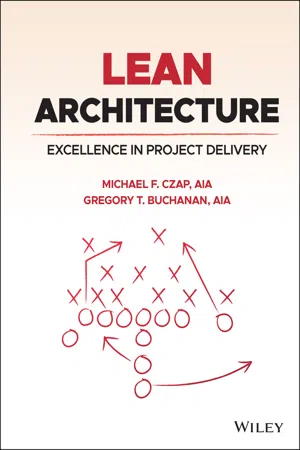
- English
- ePUB (mobile friendly)
- Available on iOS & Android
About this book
Apply lean principles to your next architectural project and improve your bottom line with the help of this practical volume
Lean Architecture: Excellence in Project Delivery shows readers a path to improve their project delivery via the application of lean concepts and process management. Authors Michael Czap and Gregory Buchanan challenge readers to reexamine their approach to architectural practice and projects by presenting a unique and compelling alternative.
Lean Architecture details the crucial metrics and implementation strategies that combine to improve the efficiency and profitability of projects taken on by firms of all sizes. Readers will learn to:
- Maximize the use of their resources to deliver superior results in less time
- Minimize waste, cost, and inefficiency in their firm's operations
- Move between radically different project scales while retaining efficient and effective processes
Lean Architecture is perfect for firm leaders, project managers, and project architects who seek to improve their ability to deliver better results while reducing their cost base. Students, designers and emerging professionals will also benefit by learning key principles for more effectively executing design ideas.
Frequently asked questions
- Essential is ideal for learners and professionals who enjoy exploring a wide range of subjects. Access the Essential Library with 800,000+ trusted titles and best-sellers across business, personal growth, and the humanities. Includes unlimited reading time and Standard Read Aloud voice.
- Complete: Perfect for advanced learners and researchers needing full, unrestricted access. Unlock 1.4M+ books across hundreds of subjects, including academic and specialized titles. The Complete Plan also includes advanced features like Premium Read Aloud and Research Assistant.
Please note we cannot support devices running on iOS 13 and Android 7 or earlier. Learn more about using the app.
Information
PART I
Building Blocks for a Lean Practice
CHAPTER 1
A Profession Ripe for Change
AN EVOLVING PROFESSION
WHERE WE ARE TODAY

- People: Most employees today are college graduates and arrive with a working knowledge of the software and hardware tools in use. In times past they would serve in an apprentice type role and learn the tools of productivity from seasoned professionals. The inverse is often true now where those individuals with the knowledge of building systems and constructability are not proficient with tools of design and production.
- Materials: Building systems have become proprietary and multifaceted. Traditional exterior materials such as masonry, stucco, and glazing remain in use; however, manufacturers have created significant differentiation within individual products and systems. Advances in building materials science has created new classes of products with elevated performance characteristics.
- Regulation: Building codes, accessibility standards, and other forms of regulation have increased and often overlap with each other.
- Time: The desire for return on investment and the ability to communicate information immediately have served to increase expectations for more rapid project delivery. The companion to this is an expectation for nearly concurrent decision‐making.
- Environmentalism: The oil embargo of the mid‐1970s and concern for the earth have brought energy efficiency to the forefront of design with a greater focus on long‐term building performance as well as understanding the health effects of the materials used. The goal of carbon neutrality is now at the forefront of sustainable design.
- Litigation: For many of the reasons noted in this chapter, the design professional's risks have increased.
THE PRIMARY OBJECTIVE
The architect's primary objective, at the most basic level, is to obtain work and progress it through the firm. The movement forward of a project is the mechanism for billing, and there are few situations where the timely advancement of work is detrimental.
SOUTHWEST AIRLINES
Table of contents
- Cover
- Table of Contents
- Title Page
- Copyright
- Foreword
- Acknowledgments
- Preface
- Introduction
- PART I: Building Blocks for a Lean Practice
- PART II: Areas of Strategic Focus with Applications
- PART III: Implementing Lean
- PART IV: Final Words and Advice
- Appendix
- Index
- End User License Agreement